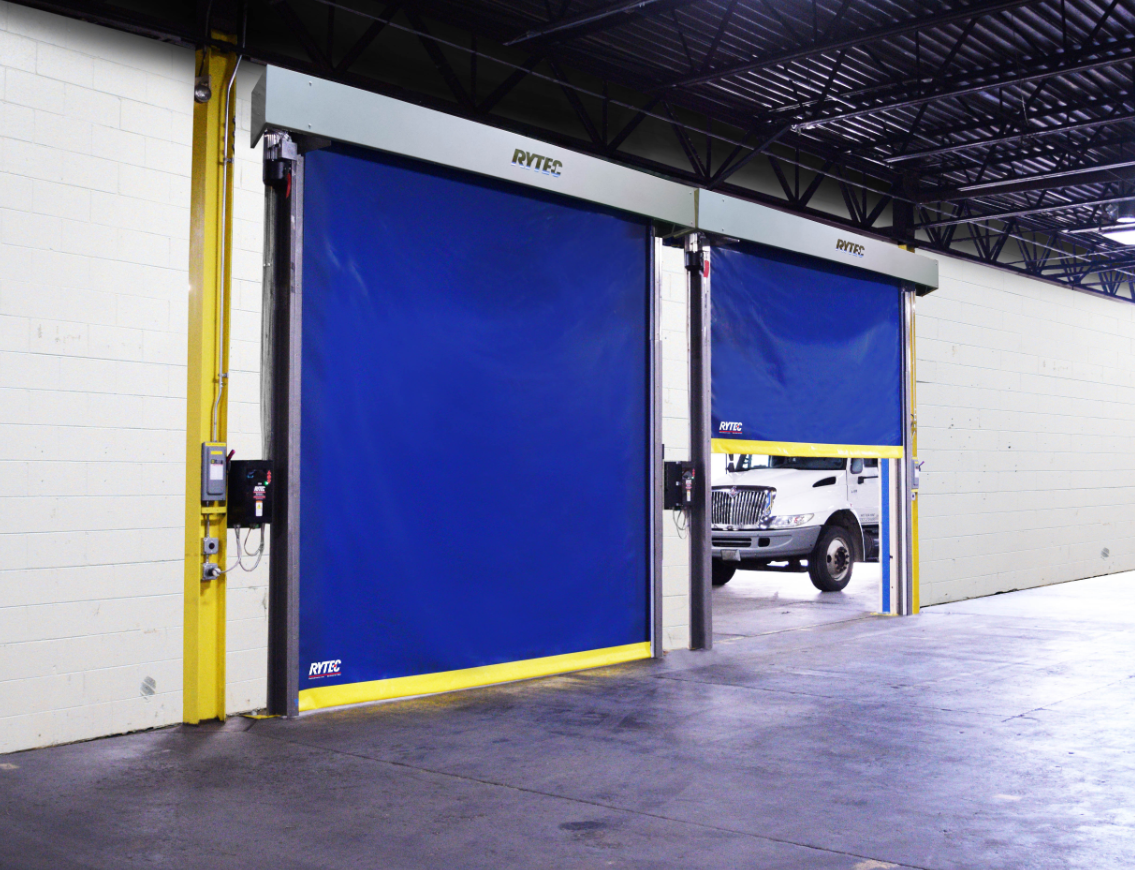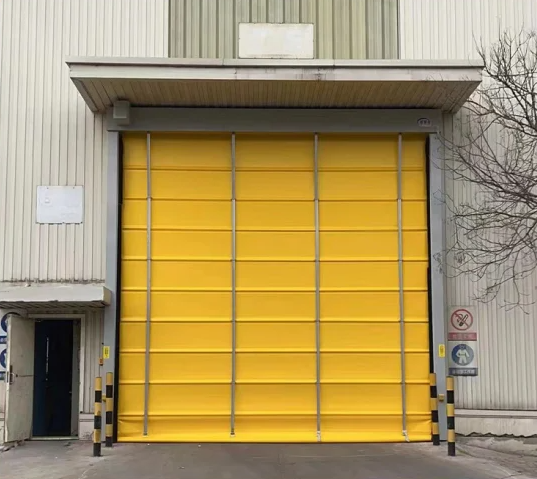The opening speed of high-performance doors can go up to 3 meters per second, depending on various factors like material and motor power.
Types of High-Performance Doors
Roll-Up Doors
Roll-Up doors are commonly used in industrial and commercial settings. These doors open vertically and roll up into a coil, saving a significant amount of space. They are highly durable and offer fast opening speeds, making them a favorite in environments like manufacturing plants and warehouses.
Material Choices: You can choose from various materials like steel, aluminum, or PVC. The material can impact both the speed and the durability of the door.
Opening Mechanism: These doors often use powerful electric motors that enable fast opening and closing speeds, usually in the range of 0.8 to 1.5 meters per second.
Safety Features: Modern Roll-Up doors include sensors that detect obstacles and prevent collisions. They also come equipped with emergency release mechanisms for quick manual operation in case of power failure.

Folding Doors
Folding Doors, also known as bi-fold doors, are ideal for locations where side space is limited but vertical space is available. They are commonly found in aircraft hangars and large vehicle maintenance facilities.
Material Choices: These doors are usually made from lightweight materials like aluminum or composite materials, contributing to their fast opening speeds.
Opening Mechanism: Folding doors often have hydraulic or pneumatic systems that enable them to open quickly and smoothly. Speeds can range from 0.5 to 1 meter per second depending on the system and door size.
Safety Features: These doors also incorporate advanced safety features, such as obstruction sensors and emergency stop functions.
Sliding Doors
Sliding Doors are commonly used in environments that require quick and easy access but have limited space for door swing. These doors are often seen in hospitals, supermarkets, and office buildings.
Material Choices: Common materials include glass for aesthetic appeal and visibility, and metal for higher security and durability.
Opening Mechanism: They usually operate on track and roller systems powered by electric motors. The speed varies but is typically in the range of 0.5 to 0.8 meters per second.
Safety Features: Infrared sensors and pressure mats are standard safety features for these types of doors. They stop or reverse the door if an obstacle is detected.
Factors Affecting Door Speed
Material Used
The material of the door significantly influences its speed. Heavy materials like steel offer durability but can reduce the speed due to the extra weight. On the other hand, lighter materials like aluminum or PVC can increase the door’s speed but might not offer the same level of security or durability.
Weight-to-Strength Ratio: This ratio determines how the material affects the speed. A better ratio usually means a faster door.
Aerodynamics: Some materials, due to their shape and texture, offer better aerodynamics which can result in higher speeds.
Motor Power
The power of the motor used in the door’s operating system is a direct determinant of its speed. Motors come in various capacities, measured in horsepower. A stronger motor can lift heavier doors at a quicker pace, but they can also consume more energy.
Torque: A motor with higher torque can accelerate the door more quickly, achieving a higher top speed in less time.
Energy Efficiency: Modern high-performance doors often use energy-efficient motors to balance speed and power consumption.
Door Size and Weight
The size and weight of the door can also impact its speed. Larger doors require more force to move, which can slow down the opening and closing process.
Surface Area: Larger surface areas can be more affected by wind resistance, which can slow down the door.
Balance and Counterbalance Systems: Some high-performance doors use advanced balance systems to offset the weight, allowing for faster speeds regardless of size.
Speed Measurements
How Speed is Measured
When it comes to high-performance doors, speed typically refers to the velocity at which the door can open or close. This is usually measured in meters per second (m/s) or feet per second (ft/s), depending on the region and industry standards. The speed is calculated by dividing the height the door moves by the time taken to complete the action.
Test Conditions: Standardized tests often measure door speeds under controlled conditions to ensure accuracy. Weather elements like wind speed or temperature are generally kept constant during these tests.
Dynamic and Static Speed: The dynamic speed refers to the speed when the door is in motion, whereas the static speed can refer to the time it takes for the door to start or stop moving.
Typical Speed Ranges
The speed of high-performance doors can vary based on design, material, and purpose. However, they generally fall within the following ranges:
Industrial Doors: These often have the fastest speeds, ranging between 1 to 3 meters per second, and are designed to accommodate large machinery and fast-paced operations.
Commercial Doors: Usually found in retail or office settings, these doors typically have speeds ranging from 0.5 to 1.5 meters per second.
Residential Doors: While not often categorized as high-performance, some advanced residential garage doors can open at speeds around 0.5 meters per second.
Specialized Doors: For specific industries like aerospace or pharmaceuticals, doors can be custom-designed for speeds exceeding 3 meters per second, although this is rare.
Industries that Require High-Speed Doors
Warehousing and Logistics
High-speed doors are crucial in warehousing and logistics operations to facilitate the rapid movement of goods. These doors minimize wait times for loading and unloading, thereby increasing overall efficiency.
Material Handling: With conveyor belts and automated systems in constant motion, the high speed of doors ensures that the flow of goods remains uninterrupted.
Inventory Turnover: Faster doors mean more cycles of opening and closing, which correlates to higher inventory turnover rates.
Security: Given that warehouses often store valuable goods, the fast closing of high-speed doors adds an extra layer of security.
Food Processing
In the food processing industry, maintaining a sterile environment is crucial. High-speed doors help in this aspect by minimizing the time that the door remains open, thereby reducing the potential for contamination.
Temperature Control: For cold storage areas, high-speed doors help in maintaining the temperature by limiting the amount of warm air that can enter.
Hygiene: Speed also contributes to higher hygiene standards, which is critical in food safety.
Pharmaceuticals
In the pharmaceutical sector, speed is of the essence not just for efficiency but also for maintaining a highly controlled environment.
Clean Rooms: In pharmaceutical clean rooms, high-speed doors help in preventing contamination by limiting air exchange with the exterior environment.
Regulatory Compliance: Faster doors can be a factor in meeting stringent industry regulations regarding contamination and quality control.

Automotive
In the automotive manufacturing industry, the assembly line is a fast-paced environment where high-speed doors are essential.
Workstation Segmentation: High-speed doors can segment different workstations, allowing for specialized conditions in each, like painting or welding, without affecting other sections.
Material Flow: The fast movement of materials from one part of the assembly line to another is facilitated by high-speed doors, reducing the production cycle time.
